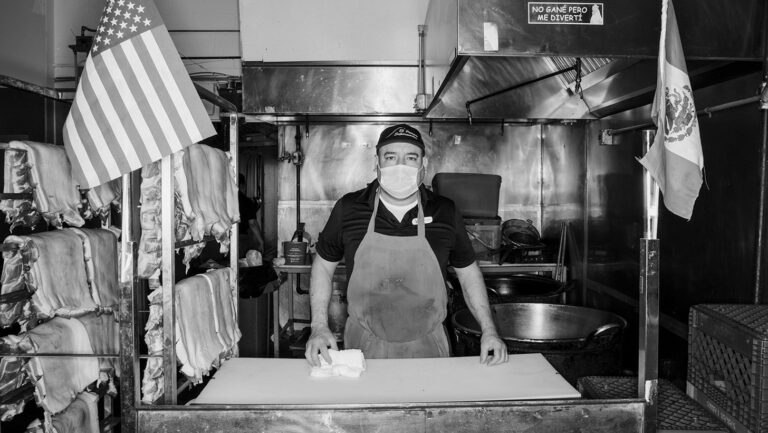Ian van Coller's work explores his memories of growing up as a white boy in South Africa during the apartheid era. In one set of pieces, Coller incorporates the concept of the traditional African memory board. Five charred-looking pieces of wood hang down from the ceiling. Each has portraits of Black men, women and children mounted on the surface with black ribbons trailing down from the bottom to the floor. In a second set of pieces, Coller frames black and white images in treated frames, ornamented with tiny blackened nails. Several of these frames look as if they're dripping with blood.
Coller's art is mournful and sad, oppressive yet also beautiful. His pieces stand as monuments to the horrors of a past of which he was barely even aware as a child.
Tomar Flores' “Memory Series” consists of nine panels, each made up of nine separate black and white images captured from the artist's daily life. This complex piece successfully represents the disjointed structure of private memories.
Michael Hudock's ten fuzzy, blurred portraits offer a different take on memory, exposing its weakness and fragility. Inspired by several famous Latina and Latino writers, Elena Baca's pretty, otherworldly oil gum prints give memory yet another twist by mythologizing remembrances of her grandmother and static dreams of loved ones.
Although there are a few weak pieces in the show—Mary Tsiongas' poorly constructed “Off the Grid” and Flores' tepid “Cloud Series”—Point of Departure is a beautifully organized exhibit. When you first enter the gallery, you're immediately confronted with Leigh Anne Langwell's monumental “Dark Field.” Influenced by her background in medical imaging, Langwell's photogram is a large-scale black and white image divided into five panels depicting something that looks like a swarm of sperm engaged in a swirling feeding frenzy. Parts of the image glow as if radiating out of an oceanic abyss.
The exhibit as a whole is bisected by Michael Berman's sprawling installation “Storm.” This is probably the most ambitious piece in the show. Constructed of a waving line of traditional-looking black and white photographs of Western landscapes suspended from the ceiling by wires, it terminates in a vertical structure wrapped with more wire and containing a kind of cubist photographic altar. At the very center is a picture of two guys fishing. “Storm” is an ambiguous but eerily powerful environmental work that explores the contours of landscapes while at the same time hinting at the ultimate mysterious impermeability of nature.
Point of Departure—which is one of many photographic exhibits being presented in Albuquerque in conjunction with the PhotoArts Santa Fe—shows how far photography has come as an art form. It's also nice to see that, to some small extent, despite their radical experimentalism, these artists continue to play with and expand on photography's original documentary purpose.
Point of Departure: Contemporary Photographic Explorations, an exhibit featuring photographic art by eight New Mexico artists, runs through August 2 at 516 Magnífico Artspace. Special Albuquerque Day, in conjunction with PhotoArts Santa Fe, occurs on Wednesday, July 16, from 4 to 7 p.m. 242-8244.








